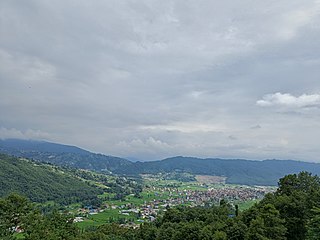Related Research Articles

Jaya Prakash Malla was the last king of Kantipur which corresponds to present-day Kathmandu. He ruled from 1736 to 1746 after succeeding his father Jagajjaya Malla, and then from 1750 until his death in 1769.

Sankhu is the ancient Newar town located in the north-eastern corner of Kathmandu Valley which is about 17 km from the city center of Kathmandu. Sankhu was formerly divided into three Village Development Committee, namely, Pukhulachhi, Suntol and Bajrayogini. Recently the town of Sankhu has been declared as Shankharapur Municipality merging three above-mentioned VDCs and other neighbouring VDCs. At the time of the 2011 Nepal census it had a population of 4333 living in 928 individual households. Sankhu lies between river Salinakhu in east and Asakhu in the west.
Raya Malla was a Malla Dynasty king and the first King of Bhadgaon after the division of Kathmandu Valley into Kantipur, Patan, and Bhadgaon following the death of his father Jayayakshya Malla. He reigned from 1482 until his death in 1505. His younger brother, Ratna Malla, ruled over Kantipur.

Siva Simha Malla, also known as Shiva Simha or Shivasimha, was a Malla ruler and the sixth king of Kantipur. He started his reign on 1578 after deposing his brother Sadashiva Malla.
Vishvajit Malla was a Malla dynasty king and the King of Patan. He succeeded Rajya Prakash Malla and reigned from 1758 until his murder in 1760.

Pratap Malla was a Malla king and the eighth King of Kantipur from 1641 until his death in 1674. He attempted to unify Kathmandu Valley by conquering Lalitpur and Bhaktapur, but failed in the effort. He was successful in extending and securing the borders of Kantipur and was responsible for the monopoly over trade with Tibet. The resulting prosperity led to the construction of the majority of the buildings around Durbar Square during his reign. His reign is seen as a cultural and economic high point of the Malla dynasty.
Ratna Malla was a Malla king and the first independent king of Kantipur. He was one of the six sons of Yakshya Malla.
Amara Malla was a king of the Malla dynasty and the third king of Kantipur. He succeeded his father Surya Malla and ruled from 1530 to 1560.
The Kingdom of Lalitpur, also known as Patan, was a kingdom ruled by the Malla dynasty of Nepal. It was established in 1482 after King Yaksha Malla's death. His sons divided the kingdom into four parts: Bhaktapur, Kantipur, Lalitpur, and Banepa.
Mahendra Malla was a king of the Malla dynasty and the fourth king of Kantipur. He succeeded his father Amara Malla and ruled from 1560 to 1574.
Sadashiva Malla was a king of the Malla dynasty and the fifth king of Kantipur. He succeeded his father Mahendra Malla and ruled from 1574 to 1578.
Lakshmi Narasimha Malla was a Malla ruler and the seventh king of Kantipur. He was the youngest son of Harihara Simha and succeeded his grandfather Shivasimha Malla in 1619 as the King of Kantipur.
Nripendra Malla was a Malla ruler and the ninth king of Kantipur. He succeeded his father Pratap Malla in 1674 as the King of Kantipur.
Parthibendra Malla was a Malla ruler and the tenth king of Kantipur. He succeeded his brother Nripendra Malla who died in 1680.
Bhupalendra Malla was a Malla ruler and the eleventh king of Kantipur. He succeeded his father Parthibendra Malla in 1687 as the King of Kantipur.
Bhaskara Malla was a Malla ruler and the twelfth king of Kantipur. He succeeded his father Bhupalendra Malla in 1700 as the King of Kantipur and also ruled Patan under the name Mahindrasimha Malla from 1717 until his death in 1722.
Jagajjaya Malla was a Malla ruler and the thirteenth king of Kantipur, comprising the Kathmandu Valley. He succeeded Bhaskara Malla in 1722 as the King of Kantipur. Jagajjaya was the grandson of Mahipatendra Malla.
Siddhi Narasimha Malla, also known as Siddhinarasimha or Siddhi Narasingh or Siddhi Nar Singh, was a Malla dynasty king and the King of Patan. He was a religious king and ruled from 1619 to 1661.
Vishnu Malla was a Malla dynasty king and the King of Patan. He succeeded Yoga Prakash Malla and reigned from 1729 until his death in 1745.
Rajya Prakash Malla, also spelled Rajyaprakash, was a Malla dynasty king and the King of Patan. He succeeded his brother-in-law Vishnu Malla and reigned from 1745 until his death in 1758.
References
- ↑ Siddika, Shamima (1993). Muslims of Nepal. Kathmandu: Gazala Siddika.
- ↑ Shrestha, Bal Gopal (2012). The Sacred Town of Sankhu: The anthropology of Newar Ritual, Religion and Society in Nepal. Newcastle upon Tyne: Cambridge Scholars. p. 57. ISBN 9781443838252.
- ↑ Shaha, Rishikesh. Ancient and Medieval Nepal (PDF). University of Cambridge. p. 61.